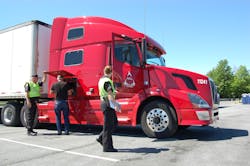The Commercial Vehicle Safety Alliance (CVSA) released the results of its 2015 Operation Safe Driver campaign this week – a seven-day campaign conducted Oct. 18-24 last year by 2,789 law enforcement officials at 706 locations across the U.S. and Canada.
Law enforcement officers pulled over 21,012 commercial motor vehicle (CMV) drivers and passenger vehicle drivers or motorists during Operation Safe Driver, the group said, along with 19,480 North American Standard Roadside Inspections.
Some of CVSA’s findings from last year's Operation Safe Driver campaign include:
- In 2015, 13,807 CMV traffic enforcement contacts were made versus 19,980 in 2014, while traffic enforcement contacts with motorists totaled 7,205 in 2015 versus 39,100 in 2014.
- Motorists speed significantly more than CMV drivers, with motorists issued a warning or citation for speeding 27.3% of the time versus 9.3% for CMV drivers.
- Yet the warning/citation percentage is up for CMV drivers from 2014, rising from 5.8% to 9.3% in 2015, while it is down considerably for motorists year over year; from 52.3% in 2014 down to 27.3% in 2015.
- In 2015, the number of warnings and citations per contact to CMV drivers was 0.58 versus 0.69 for motorists.
- The percentage of warnings and citations issued to CMV drivers for failing to obey traffic control devices increased from 2.5% in 2014 to 3.85% in 2015.
- The percentage of motorists issued warnings and citations for alcohol possession/use/under the influence in 2015 was 0.57%, down from 1.7% in 2014.
- The percentage of warnings and citations issued to CMV drivers in 2015 for failure to use seat belts reached 5%, up from 2.8% in 2014, while it increased to 8.5% for motorists in 2015 versus 4.1% in 2014.
CVSA added that the top five warnings and citations issued to CMV drivers were:
- Size and weight
- Speeding
- Failure to use a seatbelt while operating a CMV
- Failure to obey traffic control device
- Using a handheld phone
By contrast, the group said the top five warnings and citations issued to motorists were:
- Speeding
- Failure to use a seatbelt
- Failure to obey traffic control device
- Following too closely
- Improper lane change
CVSA noted that it launched Operation Safe Driver in 2007 in partnership with the Federal Motor Carrier Safety Administration (FMCSA) and other transportation safety groups to combat the number of deaths resulting from crashes involving large trucks, buses and cars as well as targeting unsafe driver behavior either in or around commercial vehicles.
About the Author
Fleet Owner Staff
Our Editorial Team
Kevin Jones, Editorial Director, Commercial Vehicle Group
Cristina Commendatore, Executive Editor
Scott Achelpohl, Managing Editor
Josh Fisher, Senior Editor
Catharine Conway, Digital Editor
Eric Van Egeren, Art Director
